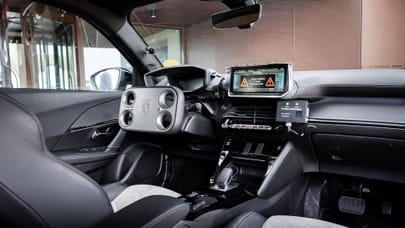
Here's how you turn a Japanese Super Formula car into a self-driving, AI racer
Check out the hardware that makes an autonomous racecar tick

Lidar

Three of these fitted – Seyond Falcon Kinetic FK1s to be precise – sending out pulsed laser beams and measuring how long it takes them to bounce back. Builds up an accurate 3D picture of the car’s surroundings.
Advertisement - Page continues belowBrakes and tyres

Brembo pads and carbon discs front and back, and Yokohama Advan slicks. Require many autonomous warmup laps to get proper heat into them... even in the UAE.

We’re as horrified by the idea of AI taking the place of our beloved racing drivers as you are, convinced the heat of competition can’t be replicated in lines of code, so we hatched a plan to put the computers in their place. A straight-up time trial shootout – Stig versus AI – whichever can set the fastest lap time from a standing start takes the spoils.
And both were driving identical cars – spec Japanese Super Formula racers. Click here to find out how the shootout went, and keep scrolling to see how computers made a racing car drive all by itself...
Photography: Rowan Horncastle
Advertisement - Page continues belowEngine

A humble four-cylinder turbo, albeit one with pedigree. This is Honda’s K20C1 unit, closely related to the Civic Type R lump but strengthened and boosted up to 550bhp, and run through a 3MO six- speed paddleshift gearbox. Theoretical top speed of 186mph.
Radar

Operate much like lidar, using pulses of electromagnetic waves instead of lasers to form a picture. There are three fitted here – ZF ProWaves in case you fancy fitting a couple to your old dog that keeps bumping into things.
VR camera

An 8K, 360° onboard camera capable of transmitting data in real time to the A2RL app. Essentially, if you own a Meta Quest VR headset, you can ride onboard in real time with the AI car during the race. Clever stuff – also great for enjoying engine fires right in the heat of the action.
Cameras

Seven Sony IMX728 cameras mounted all over the place to offer 360° coverage around the car. Used mostly for something called camera lock – to enable high speed overtaking manoeuvres, and selfies obvs.
Advertisement - Page continues belowGPS

Dual Antenna GPS system – one in the nose, another mounted high above the central air intake – deliver info on the car’s location to the nearest 10cm. Yeah, but does it have Waze?
Chassis

Dallara's EAV24 chassis underpins this SF23 Japanese Super Formula racer, albeit modified to house and hide all the autonomous sensors and actuators. Pushrod suspension front and rear, carbon everywhere, 660kg all in... this is a very serious racecar.
Advertisement - Page continues belowComputer

Geeks assemble! That blue box buried in the there is a Neousys RGS-8805GC, essentially a rugged HPC server designed to work in the field, not just an air-conditioned room. Doesn’t run on Windows 95.







